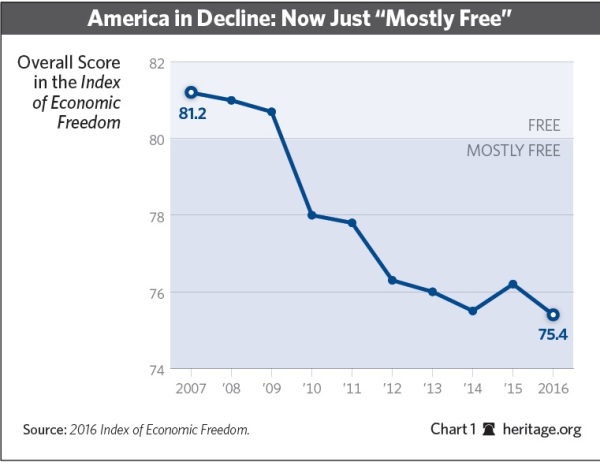The Index of Economic Freedom, my favorite Heritage Foundation publication, wasreleased today.
 As one might predict, Hong Kong once again ranks as the jurisdiction with the most liberty to engage in mutually beneficial exchange, followed by Singapore. Other highly ranked nations include New Zealand,Switzerland, and Australia.
As one might predict, Hong Kong once again ranks as the jurisdiction with the most liberty to engage in mutually beneficial exchange, followed by Singapore. Other highly ranked nations include New Zealand,Switzerland, and Australia.
Chile deserves special attention since it is the highest-ranked nation from its region and also the highest-ranked nation from what is considered to be the developing world. Estonia also deserves plaudits for being the highest-ranked nation to emerge from the former Soviet Empire.
The United States, sadly, isn’t in the top 10.
Now let’s look at some of the details from the report, starting with the important observation that good policy produces good results.
…lasting prosperity is a result of a persistent commitment to limited government, strong private property rights, openness to global trade and financial flows, and sensible regulation. Together, these interrelated factors have been proven to empower the individual and induce dynamic entrepreneurial activity. …nations that have focused on improving their competitiveness and opening their societies to new ideas, products, and innovations have done a much better job of achieving the high levels of social progress.
Looking at specific data, the good news from a global perspective is that there’s never been more economic freedom.
…economic freedom has advanced for the fourth year in a row. The world average economic freedom score for 178 economies…recorded an overall average improvement of 0.3 point from the previous year. The global average economic freedom score of 60.7 is the highest recorded in the 22-year history of the Index.
To be sure, a global average of less than 61 percent means a barely passing grade. But that’s better than a failing grade.
Moreover, there’s been some noteworthy improvement in selected countries.
Hong Kong, Singapore, New Zealand, Switzerland, and Australia…earned the designation of “free” with scores above 80. …Ninety-seven countries, the majority of which are less developed, gained greater economic freedom over the past year; 32 countries, among them Burma, Germany, India, Israel, Lithuania, the Philippines, Poland, and Vietnam, achieved their highest economic freedom scores ever in the 2016 Index. …Score improvements in eight countries were significant enough to merit upgrades in the countries’ economic freedom status in the Index. Notably, Latvia became a “mostly free” economy for the first time.
But we also have some bad news.
Declining economic freedom was reported in 74 countries, including 19 advanced economies such as the United States, Japan, and Sweden. …Within the top five freest economies, Switzerland is the only economy whose overall score did not decline in the 2016 Index.
Indeed, I’m worried that Hong Kong’s score fell by a full point and Singapore tied for the 5th-biggest decline with a drop of 1.6 points. Those two jurisdictions are supposed to be role models!
And if you’re an American reader, you probably won’t be happy to learn that the United States has never had a lower score.
The United States continues to be mired in the ranks of the “mostly free,” the second-tier economic freedom category into which the U.S. dropped in 2010. Worse, with scores in labor freedom, business freedom, and fiscal freedom notably declining, the economic freedom of the United States plunged 0.8 point to 75.4, matching its lowest score ever.
You can see from this chart how policy has been moving in the wrong direction.

I don’t want to be overly glum. Only 10 nations rank above the United States and more than 160 jurisdictions get lower scores. And being “mostly free” is better than being “moderately free” or “mostly unfree.” Or, Heaven forbid, being a “repressed” nation such as Argentina, Venezuela, Cuba, or North Korea.
That being said, the trend is not in the right direction. Heck, America is only 1/10th of a point ahead of Denmark (though, to be fair, Bernie Sanders would be horrified to learn that the Danes have very pro-market policies once you get past their awful fiscal system).
One final comment. The much-vaunted BRICS have hit a speed bump.
Progress among the so-called BRICS nations (Brazil, Russia, India, China, and South Africa) has stalled, except in India, which improved by 1.6 points. Russia plunged 10 places in the rankings to 153rd, with its score deteriorating by 1.5 points. The rankings of the other BRICS countries—South Africa, Brazil, and China—declined to 80th, 122nd, and 144th, respectively.
By the way, India’s improvement is welcome news, but don’t break out the champagne. It still only ranks #123 in the world, which is not a recipe to become an Asian Tiger.
Indeed, the big lesson from the BRICS (as I’ve explained in my analyses of Brazil,South Africa, and China) is that a little bit of economic liberalization is a good thing and can help save a huge number of people from destitution. But you don’t become a rich nation with “mostly unfree” policy.
P.S. While I’m a big fan of the Index of Economic Freedom, I’m an even bigger fanof Economic Freedom of the World. But both tell a very similar story about the relationship between good policy and good outcomes.
For more information, here’s the CF&P video I narrated on the recipe for growth and prosperity.

